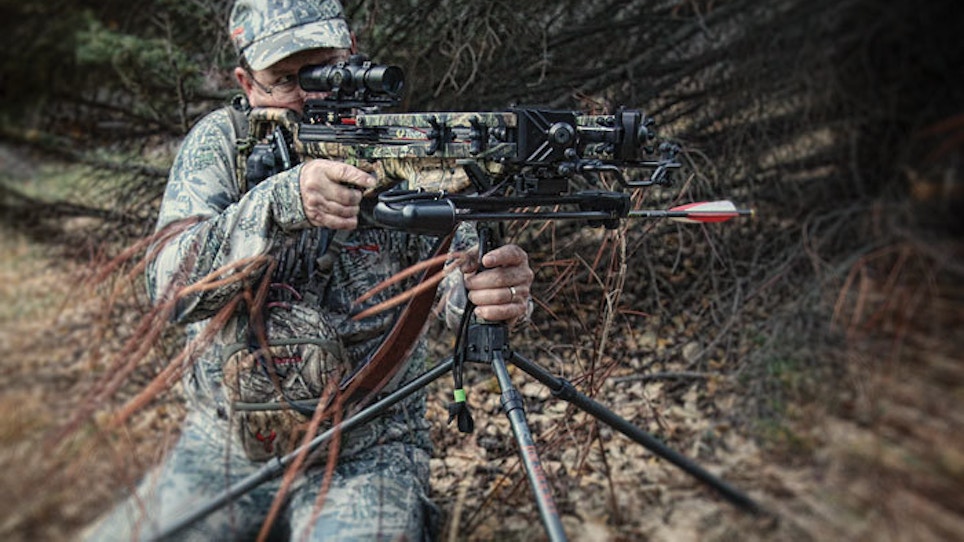I caught movement out of the corner of my eye and slowly turned to see a deer headed in my direction. I was caught a bit off guard and immediately the left-brain, right-brain struggle began. Right brain says: Lift your crossbow. Do it now before he gets too close. Left brain says: Don’t lift your crossbow now. Wait. You don’t want to be shaking and tired by the time he gets here. Wait for the window of opportunity when the deer closes the distance.
With any type of horizontal or vertical bowhunting there is a moment in time when our decisions can lead us down a road of success or failure. Some archers believe the crossbow provides a huge advantage because you don’t have to draw it when your quarry is close, so movement is minimized. But most hunting scenarios involve a vertical backdrop, made up of trees and grass. Meanwhile, crossbows have horizontal limbs. That horizontal-limb-on-vertical-backdrop makes it easy for animals to pick up on any movement of the crossbow.
In order to beat the keen eyes of any game animal, the best option is to let your right brain win the struggle – get ready for the shot as early as possible. You need to remove the left-brain argument and instead use some type of rest or support to prevent fatigue.
For years I used treestands with no rails. I liked the open vista in front of me, and reducing the chances that something might create noise or hinder my shot felt like a big bonus. Maybe it’s the fact I’m not as young as I used to be but having a rest is now almost a must.
How do you know if you need a rest? Simply do a hold test at home by lifting your crossbow to the shooting position and holding your crosshairs or open sights steady for one full minute. Do your crosshairs or pins start to bob and weave like a prize fighter? I’m guessing the answer to my question is yes. Now try holding your horizontal rig steady for two minutes. Are you breaking a sweat? Trembling? Probably. Ready for more bad news? This sweating and trembling is happening without the pressure of a trophy buck moving in on your position. The simple fact is most crossbow goers need a shooting rest whether in a treestand, in a ground blind, or when spotting and stalking.
If you’re still not convinced you need a rest, do the same hold test with some type of support. You’ll quickly note the difference. In my mind, the advantage of the crossbow isn’t the fact you don’t have to draw it when game is close, but the fact that you can use a rest or support to hold steady.
What about those super-challenging days when the wind is howling? I don’t know about you, but I’ve hunted with both vertical and horizontal bows for a number of years, and the second I lift either into the shooting position when the wind is kicking my stability goes down the toilet. It’s as if the wind uses your weapon as a kite and pulls you off-target. You can’t use a rest on a vertical bow in the wind, but you sure can with a horizontal bow.
All of my treestands are now equipped with shooting rails. Not only are they an added safety feature, but they also help minimize movement by allowing you to sit in the semi-ready position with your crossbow resting on the bar. I strongly recommend padding the rail, as it is easy to make accidental noises by hitting the bow against the metal. Shooting rails work very well for conventionally drawn limbs, as you can ensure they are in front of the support before pulling the trigger, and at the shot, they move out and away from the rail. If you’re using a reverse-draw crossbow, you need to pay ultra-close attention to make sure the limbs don’t make contact with the rest when fired, as they will come toward the rail.
When hunting on the ground or out of a blind I often use shooting sticks. Whether you’re sitting on the ground or in a chair, the sticks can be set at a height to cover most shot angles. Most shooting sticks support the forestock, so they help balance your bow and guard against limb contact.
I love spot-and-stalk hunting, and the Primos Trigger Stick is the only rest you can adjust on the fly. You can make the legs longer or shorter in seconds without having to adjust individual leg length. With just one hand and the pull of the trigger on the Trigger Stick, you can adjust the rest to your desired height. The legs spread wide, so it’s ideal for sitting on the ground and calling in a big old tom. Plus, the legs extend fully, which makes it a great option for hunting in the heavy brush or tall grass when you need to stand and shoot.






